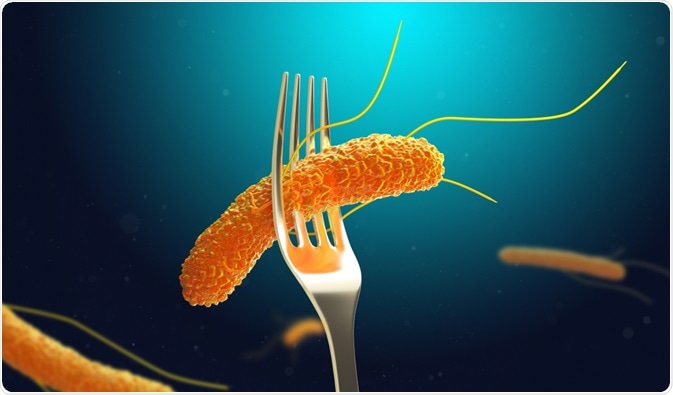Salmonella is an important bacterial genus that causes one of the most common forms of food poisoning worldwide. Throughout history, typhoid fever, which is caused by Salmonella enterica serovar Typhi, triggered many dire outbreaks. Over time, people eventually recognized the link between this disease and contaminated food or beverages.

Image Credit: Festa / Shutterstock.com
Karl Joseph Eberth, who was a physician and student of Rudolf Virchow, discovered the bacillus in the abdominal lymph nodes and the spleen in 1879. After he had published his observations in 1880 and 1881, his discovery was subsequently confirmed by German and English bacteriologists, including Robert Koch.
The genus “Salmonella” was named after Daniel Elmer Salmon, who was a veterinary pathologist who ran the United States Department of Agriculture (USDA) microorganism research program in the 1800s. Together with Theobald Smith, Salmon found Salmonella in hogs that succumbed to the disease known as hog cholera.
The story of Mary Mallon
Typhoid Mary: The Bringer of Disease and Death
Mary Mallon was born in Ireland and immigrated to the United States in 1884. She is considered the first famous carrier of typhoid fever in the United States. Initially working in 1906 as a cook for Charles Henry Warren, a wealthy New York banker, Mallon was subsequently hired as a cook at several private homes throughout the New York area.
Moving from household to household, Mary Mallon caused several typhoid outbreaks, always vanishing before an epidemic could be traced back to the particular household she was working in. Mary represents the first known case of a healthy carrier in the United States and was proven responsible for the contamination of at least 122 people, five of whom died as a result of the infection.
In 1907, almost 3,000 inhabitants of New York had been infected by Salmonella Typhi, with Mallon probably being the main reason for the outbreak. Due to a lack of antibiotic treatment and no immunization option at the time, a dangerous source like Mary Mallon had to be restrained.
After police intervened and Salmonella had been found in Mary’s stool, she was transferred to North Brother Island to Riverside Hospital, where she was quarantined in a cottage. As she was the first known healthy carrier of typhoid fever in the United States, she did not understand how someone healthy could spread disease; hence, she tried to fight back.
Although the New York Supreme Court dismissed her petition for release, the city’s new health commissioner Ernst J. Lederle took pity on Mallon and released her on the promise that she will never again work as a cook. Nevertheless, she was found to be working as a cook, which was again causing typhoid outbreaks. She was sent back to North Brother Island, where she lived until her death in 1938.
There is still much speculation regarding the treatment that Mary received at the hands of the New York’s Department of Health. Instead of working with her to make her realize she was a risk factor, the state quarantined her twice and turned her into a laboratory pet. This case is often cited as an example of how the health care system provokes prejudiced social attitudes towards disease carriers.
Salmonella outbreaks
Historians and scientists have studied outbreaks in the past and have come to the conclusion that many of these outbreaks may have been due to typhoid infections. Around the year 430 B.C., a plague thought to be an outbreak of typhoid fever killed one-third of all the people in Athens which, at the time, was one of the most powerful cities in ancient Greece.
Salmonella infections have been present in America since at least the early 1600s. Scholars studying the history of Jamestown in Virginia believe that typhoid fever was responsible for the deaths of over 6,000 settlers between 1607 and 1624. Moreover, typhoid fever was the major killer in the Spanish-American war of 1898 as well.
Due to vaccinations and advances in public sanitation, the incidence of typhoid fever in developed countries plummeted to approximately 5 cases for each one million people per year. Nevertheless, outbreaks caused by other Salmonella serovars are commonly observed.
One of the deadliest Salmonella outbreaks occurred in 1985 when approximately 6,149 cases of Salmonella Typhimurium were reported among people who had consumed 2% pasteurized milk sold in northern Illinois, of which 5,770 were laboratory-confirmed.
References
Further Reading